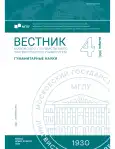Syntax of Communication Web 2.0
- Authors: Vanko T.R.1
-
Affiliations:
- Moscow State Linguistic University
- Issue: No 4(898) (2025)
- Pages: 26-32
- Section: Linguistics
- URL: https://journal-vniispk.ru/2542-2197/article/view/291857
- ID: 291857
Cite item
Full Text
Abstract
The purpose of the work is to describe the syntax of Web 2.0 digital communication, which allows the coexistence of two types of content: adapted traditional and user-generated content. The relevance of the study is determined by the insufficient study of their syntactic characteristics, and the novelty is due to the chosen vector of comparative analysis of syntactic parameters and syntactic means of realizing the subjective-modal potential of the user-generated content and its traditional analogue based on the material of professional and amateur film reviews. The results of the study indicate a trend towards convergence of syntactic characteristics of adapted and usergenerated content of Web 2.0 communication.
About the authors
Tatiana Rostislavovna Vanko
Moscow State Linguistic University
Author for correspondence.
Email: bestgrammar@yandex.ru
PhD (Philology), Associate Professor at the Department of English Grammar and the History of the English Language, Faculty of the English Language
Russian FederationReferences
- Herring, S. (2013). Discourse in Web 2.0: Familiar, Reconfigured, and Emergent. Discourse 2.0. Language and New Media. Georgetown University Press. Washington DC, 1–27.
- Goroshko, E. I. (2009). Tekst ehpokhi Veb 2.0: psikholingvisticheskij analiz = Text of the Web 2.0 Era: Psycholinguistic Analysis. Voprosy psikholingvistiki, 9, 267–280.
- Tannen, D. (2013). The Medium is the Metamessage: Conversational Style in New Media Interaction. Discourse 2.0. Language and New Media, 99–117.
- Klushina, N. I. (2018). O digitalizacii yazyka = On the digitalization of language. Philological conversations. Russian Speech, 6, 52–56. (In Russ.)
- Vanko, T. R. (2022). ‘Digital native media’ syntax. Vestnik of Moscow State Linguistic University. Humanities, 3(858), 16–22. (In Russ.)
- Trofimova, G. N., Barabash, V. V. (2020). The Linguistic Aftertaste of the Internet Era in Russia: the Boomerang Effect (Current Processes in Russian-Language Digital Media Communication). Moscow: RUDN University. (In Russ.)
- Shkaiderova, T. V. (2014). The Adaptation of a Film Review to New Media Conditions. Communicative Research, 2, 141–145. (In Russ.)
- Turko, U. I. (2024). Smiley, emoticon, and emoji as nonverbal communication tools in internet communication. Philological Sciences. Questions of Theory and Practice, 17(9), 3005–3011. (In Russ.)
Supplementary files










